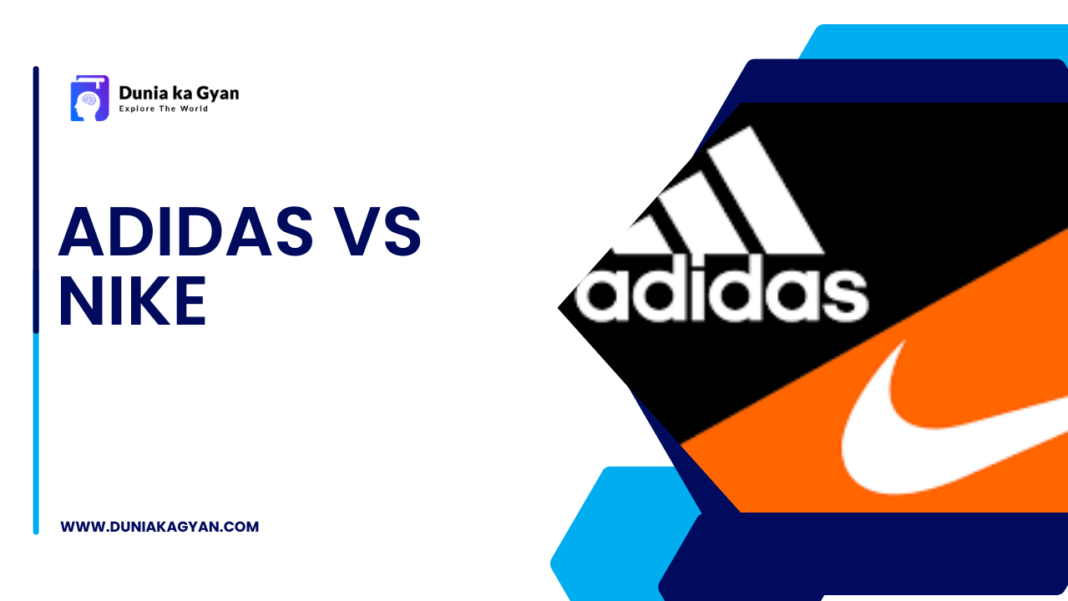There are two brands in today’s market that have found the perfect combination of comfort, sportswear, and fashion, and they are Adidas and Nike. The two giants have shaped cultures and continue to exert their influence in the trends of style and performance. Whether you follow them for their sponsored teams, athletes, or just for their products, there’s always the question of which brand is better in the Adidas vs Nike debate.
Here, Duniakagyan will compare the two brands in every major aspect, such as history, products, their innovations, and market dominance. This will help you, as a consumer, choose the brand that suits your likings and philosophy.
History and Growth
Let’s take a look at the history behind both Adidas and Nike to understand how these companies have shaken their respective industries.
Adidas
Adidas started producing sports shoes right after World War I, by Adolf “Adi” Dassler. Adi started manufacturing shoes in his mother’s house, and in the 1936 Berlin Olympics, Jesse Owens, an American trac-and-field athlete, started wearing Adidas shoes at events. This brought the world’s attention on Adidas, and set the stage for one of the biggest apparel brands in the world.
Since the 1950s, Adidas expanded into soccer/football shoes, manufacturing them for some of the biggest teams at the time. In 1963, it also started producing apparel, soccer balls, and sliders, which are still common to this day.
Adidas now holds a 15.6% market share in the shoe segment, which makes it one of the largest shoe manufacturing brands in the planet. For apparels, Adidas also has a 15.4% market share for apparel shoes, and 14.7% hold in the sneaker industry. These figures are based on 2022’s reports.
Nike
Nike, or Nike, Inc., was founded in 1964 by American businessmen Bill Bowerman and Phil Knight. Nike’s always had a more individual-based approach to its marketing and products. In fact, Nike has signed massive deals with athletes like Michael Jordan, Serena Williams, and Tiger Woods.
When Nike spent a massive chunk of its marketing budget in 1984 to sign Michael Jordan, it ventured into the “sneaker culture” that is so prevalent today.
The Nike Air Jordans was the start of a culture that represented history, community, and acted as a fashion statement. Sneakers have now also become collectibles. As an example, a pair of Nike Air Jordan 13s that were used by Michael Jordan was auctioned off for $2.2 million in April 2023.
The company also holds a staggering 38.2% share of the total footwear market, as of 2024. Nike now goes head-to-head with Adidas in multiple segments, including sports apparel, sneakers, and soccer boots.
Technology Difference
Both Adidas and Nike try to edge out each other in terms of innovation on their wares. In the age-old Adidas vs Nike debate, it’s also important to understand how these companies use technology to be more attractive to customers and push the boundaries of sportswear.
Adidas
Adidas takes its German heritage and proudly presents its latest products as the perfect amalgamation between technology and innovation. It believes in efficiency, ensuring that each of its products are designed with cutting-edge technology that provides the best comfort and performance for intense activities.
The company has also often been considered a technology company disguised as an apparel brand. By using data science, analytics, AR and VR technology, and even machine learning, the company ensures that it considers every major trend in the world when creating a new product.
To give you an idea, Adidas has invested exorbitant amounts of money into developing its products with technologies like Adiprene, Adiwear, Torsion, Bounce, and Climacool. Each technology is used in specific instances and products. For example, Climacool is a material that dissipates heat from the athletes body during intense activity. This keeps the athlete cooler and fresher for longer.
Nike
Nike’s approach to technology is a little bit different than that of Adidas. While the company does use the latest technologies for its products, it focuses more on customer experience with technology.
In fact, Nike has been known to delve into The Metaverse, NFTs, and and Web3 to provide a more holistic customer service experience. For instance, Nike’s used The Metaverse to provide a virtual experience to its patrons, called the Nikeland. Here, customers can create their own “yard”, where they can show off their Nike collectibles and customize the yard based on their personality.
In other words, Nike aims to create an experience of an aspirational lifestyle for its patrons and the community. With Nike, consumers can expect the highest quality of lifestyle apparel, ensuring that they aim for bigger and better goals. Nike essentially uses technology to foster a community of its consumers.
Business Model
The business models of both apparel giants is also quite different from each other. Let’s understand this in a bit more detail.
Adidas
The German company takes precision and efficiency as its core values. Keeping this in mind, it makes sense for the brand to focus on products that provide excellent performance in every condition. It focuses less on brand deals and partnerships, and instead goes for streamlining the product manufacturing process.
In terms of customer experience, Adidas aims to satisfy customers in every major aspect, such as product quality, customer service, and the consumer shopping experience. Essentially, Adidas aims to remove complexity at the consumer level, ensuring that they get the best products for performance with little to no hassle in terms of service.
Nike
Nike’s approach to business is vastly different to that of Adidas. The brand maintains that its products are created with the latest technology. However, it’s more focused on closing brand deals with the most popular entities in the world, which include sportspeople.
For example, a big part of Nike’s business comes from brand endorsements with athletes who have a large social media following. This way, they are able to reach different communities and showcase their products, which are styled after closely interacting with the brand ambassadors.
A case in point would be the design of the Nike Air Jordans, which were designed with Michael Jordan. The shoes represented the best of the Black American community at the time, including their history, style, and aspirations.
Future Plans
It’s easy to determine that both apparel giants will go for growth as a major part of their respective future plans. However, let’s dive into this in a bit more detail.
Adidas
As of 2023, the German company is planning a change in its outlook, both for itself and its consumers. From the iconic “impossible is nothing” logo, Adidas now plans to change their motto to “you got this”.
Additionally, seeing a loss in sales by 7.6% in 2023 following Adidas’ break from the Yeezy line, the brand is now going for a more local approach. Adidas no longer wants to create a global apparel line and try to sell it worldwide. Instead, it aims to go into the local sector, ensuring that it honors the various local communities and takes inspiration from them.
There’s also a change in the visuals, with the Adidas logo appearing in a more streamlined form in all its apparel lines. Overall, it seems like Adidas’ approach towards global relevance is about to end, giving way to local relevance instead.
Nike
In Nike’s 2025 Target Summary page, the brand aims to bring some worthwhile changes for the future. This includes providing more representation to women and racial minorities in leadership roles (50% and 35% respectively), maintaining a 100% equity pay across all employee levels.
It also plans to introduce carbon neutrality across all its operation sectors by 2025, and climate neutrality in its global operations by 2050. Along with this, Nike plans to ensure that 50% of its operations become more digital-driven.
Conclusion
Adidas and Nike have been battling over supremacy in the sportswear and apparel line for decades. Recently, it was reported that Nike would become the kit manufacturer for the German National Football Team in 2027. This marks a massive change in the battle of the giants, as Germany has partnered with Adidas for its kits from 1954 to 2026.
Considering this change, Adidas is bound to make waves elsewhere in the global market when vying for domination. Considering this and the factors we’ve listed in this post, this is a battle to keep a close eye on!
FAQs
Adidas has a longer history than Nike, as it was founded in 1936 and Nike was founded in 1964.
Adidas’ product line includes some stalwarts like Adidas Samba, Adidas NMD R1, and Adidas Stan Smith trainers. Its rival, Nike, has products like the massively popular Nike Air Jordans, Nike Air Force 1, and Nike Air Pegasus.
Nike is currently leading the apparel market share, with a whopping 29% of global market share, as of 2021. Adidas is behind Nike, with 17% market share.
Adidas has collaborated with celebrities like Pharrell Williams, Beyonce, Bad Bunny, and sportspersons like soccer legend Lionel Messi.
On the other hand, Nike has always concentrated on brand deals with big personalities. It has collaborated with Michael Jordan, Tiger Woods, LeBron James, and Serena Williams. Other notable personalities include Travis Scott and Kendrick Lamar.




